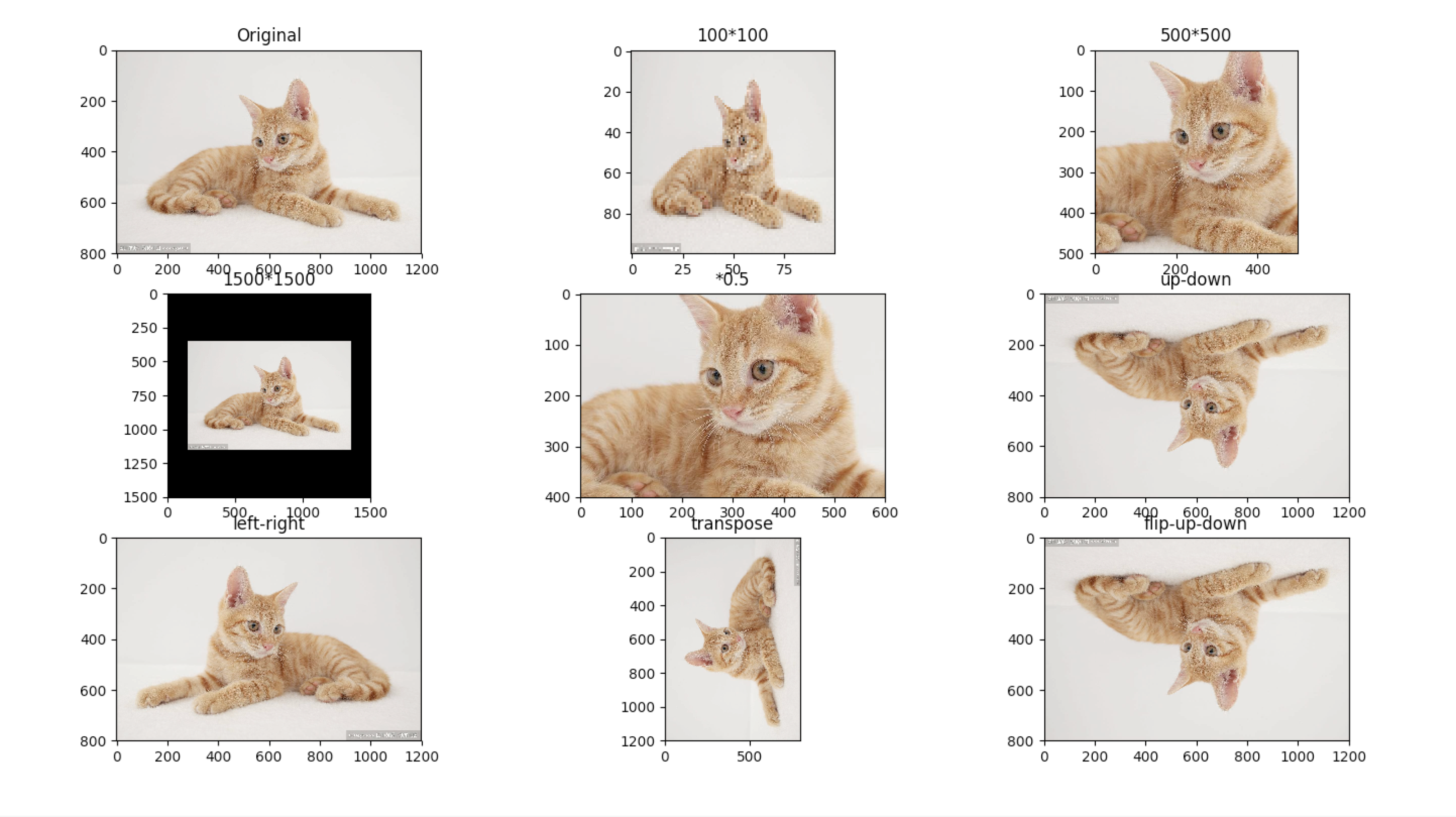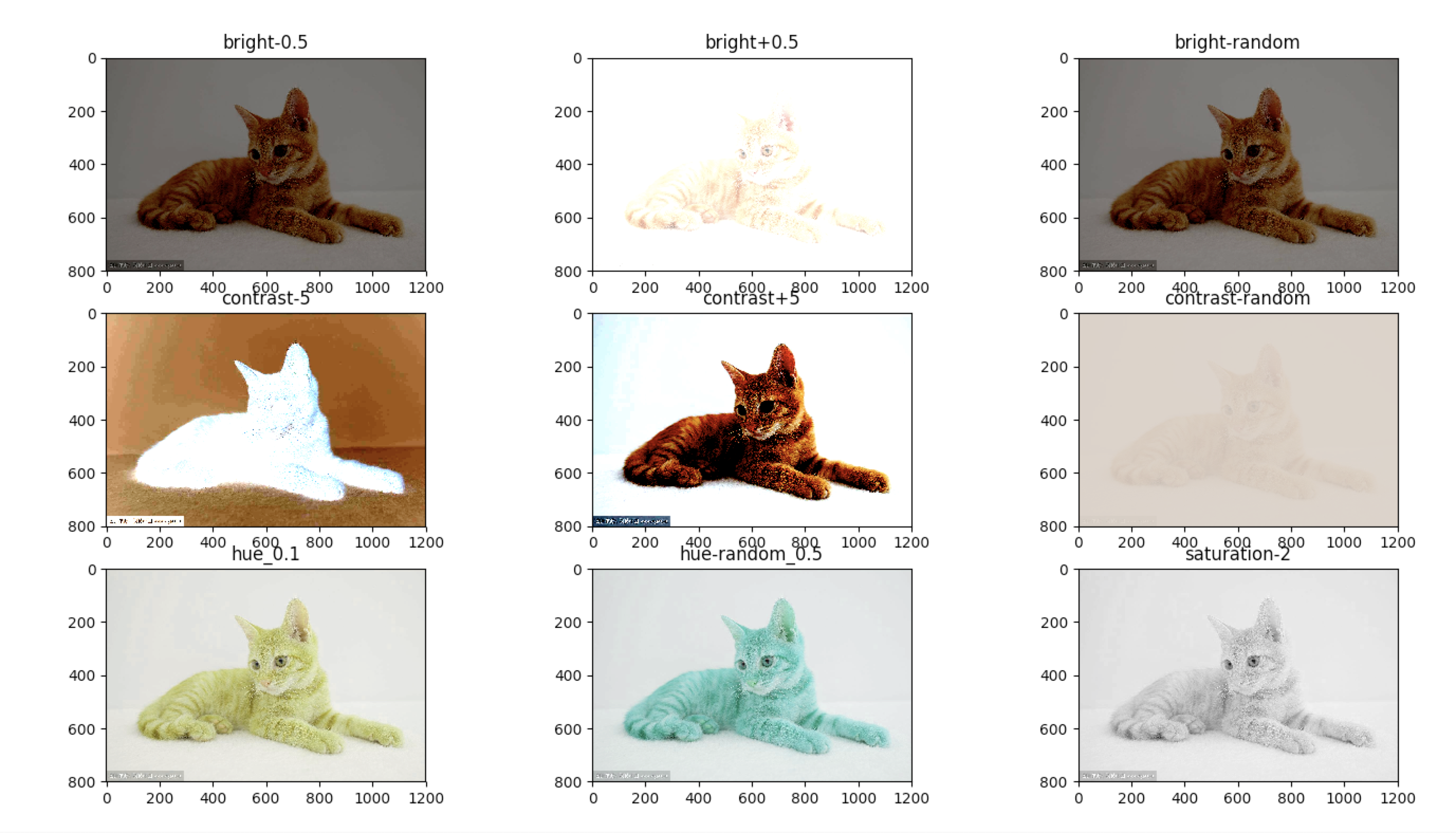Tensorflow图像处理主要包括:调整尺寸,图像翻转,调整色彩,处理标注框。
代码如下:
#coding=utf-8
import matplotlib.pyplot as plt
import tensorflow as tf
import numpy as np
image_raw_data = tf.gfile.FastGFile('cat.jpg','rb').read()
with tf.Session() as sess:
img_data = tf.image.decode_jpeg(image_raw_data)
plt.subplot(331)
plt.title("Original")
plt.imshow(img_data.eval())
#plt.show()
resized = tf.image.resize_images(img_data, [100, 100], method=0)
# TensorFlow的函数处理图片后存储的数据是float32格式的,需要转换成uint8才能正确打印图片。
print("Digital type: ", resized.dtype)
resized = np.asarray(resized.eval(), dtype='uint8')
# tf.image.convert_image_dtype(rgb_image, tf.float32)
plt.subplot(332)
plt.title("100*100")
plt.imshow(resized)
#plt.show()
croped = tf.image.resize_image_with_crop_or_pad(img_data, 500, 500)
padded = tf.image.resize_image_with_crop_or_pad(img_data, 1500, 1500)
plt.subplot(333)
plt.title("500*500")
plt.imshow(croped.eval())
# plt.show()
plt.subplot(334)
plt.title("1500*1500")
plt.imshow(padded.eval())
#plt.show()
central_cropped = tf.image.central_crop(img_data, 0.5)
plt.subplot(335)
plt.title("*0.5")
plt.imshow(central_cropped.eval())
# plt.show()
# 上下翻转
flipped1 = tf.image.flip_up_down(img_data)
plt.subplot(336)
plt.title("up-down")
plt.imshow(flipped1.eval())
#plt.show()
# 左右翻转
flipped2 = tf.image.flip_left_right(img_data)
plt.subplot(337)
plt.title("left-right")
plt.imshow(flipped2.eval())
#plt.show()
# 对角线翻转
transposed = tf.image.transpose_image(img_data)
plt.subplot(338)
plt.title("transpose")
plt.imshow(transposed.eval())
# plt.show()
flipped3 = tf.image.random_flip_up_down(img_data)
plt.subplot(339)
plt.title("flip-up-down")
plt.imshow(flipped3.eval())
plt.show()
#————————————————————————————————————————————#
# 将图片的亮度-0.5。
adjusted = tf.image.adjust_brightness(img_data, -0.5)
plt.subplot(331)
plt.imshow(adjusted.eval())
plt.title("bright-0.5")
#plt.show()
# 将图片的亮度0.5
adjusted = tf.image.adjust_brightness(img_data, 0.5)
plt.subplot(332)
plt.imshow(adjusted.eval())
plt.title("bright+0.5")
#plt.show()
# 在[-max_delta, max_delta)的范围随机调整图片的亮度。
adjusted = tf.image.random_brightness(img_data, max_delta=0.5)
plt.subplot(333)
plt.imshow(adjusted.eval())
plt.title("bright-random")
#plt.show()
# 将图片的对比度-5
adjusted = tf.image.adjust_contrast(img_data, -5)
plt.subplot(334)
plt.imshow(adjusted.eval())
plt.title("contrast-5")
#plt.show()
# 将图片的对比度+5
adjusted = tf.image.adjust_contrast(img_data, 5)
plt.subplot(335)
plt.imshow(adjusted.eval())
plt.title("contrast+5")
#plt.show()
# 在[lower, upper]的范围随机调整图的对比度。
adjusted = tf.image.random_contrast(img_data, 0.1, 0.6)
plt.subplot(336)
plt.imshow(adjusted.eval())
plt.title("contrast-random")
#plt.show()
# 调整图片的色相
adjusted = tf.image.adjust_hue(img_data, 0.1)
plt.subplot(337)
plt.imshow(adjusted.eval())
plt.title("hue_0.1")
#plt.show()
# 在[-max_delta, max_delta]的范围随机调整图片的色相。max_delta的取值在[0, 0.5]之间。
adjusted = tf.image.random_hue(img_data, 0.5)
plt.subplot(338)
plt.imshow(adjusted.eval())
plt.title("hue-random_0.5")
#plt.show()
# 将图片的饱和度-5。
adjusted = tf.image.adjust_saturation(img_data, -2)
plt.subplot(339)
plt.title("saturation-2")
plt.imshow(adjusted.eval())
plt.show()
# 在[lower, upper]的范围随机调整图的饱和度。
#adjusted = tf.image.random_saturation(img_data, 0, 5)
# 将代表一张图片的三维矩阵中的数字均值变为0,方差变为1。
#adjusted = tf.image.per_image_standardization(img_data)
效果图:

